SPECIAL THANKS Thank you to Katharine Garrison and the City of Overland Park, Kansas for providing a beautiful setting for quilt photography. Publisher: AMY MARSON Creative Director: GAILEN RUNGE Editor: JENIFER DICK Technical Editor: NAN POWELL Cover/Book Designer: SARAH MEIERS Illustrator: LOGAN WRIGHT All photography by AARON T. LEIMKUEHLER Published by Stash Books, an imprint of C&T Publishing, Inc., P.O. Box 1456, Lafayette, CA 94549 ACKNOWLEDGEMENTS For my husband, Ray; and three children: Nick, Tyler and Kiley; for putting up with the whole book writing and quilt making process.They are my tree of life.
Publisher: AMY MARSON Creative Director: GAILEN RUNGE Editor: JENIFER DICK Technical Editor: NAN POWELL Cover/Book Designer: SARAH MEIERS Illustrator: LOGAN WRIGHT All photography by AARON T. LEIMKUEHLER Published by Stash Books, an imprint of C&T Publishing, Inc., P.O. Box 1456, Lafayette, CA 94549 ACKNOWLEDGEMENTS For my husband, Ray; and three children: Nick, Tyler and Kiley; for putting up with the whole book writing and quilt making process.They are my tree of life. TRADITIONAL INSPIRATION I have always loved Tree of Life quilts and motifs in general. I have had a design in my head for years that I have always imagined I would make based on the more historical Tree of Life tapestries and textiles that depict an elaborate tree filled with animals hidden in every nook and cranny. I still think I might make that quilt someday probably on a smaller scale than I originally thought. I love the diversity, breadth of design and longevity of Tree of Life designs.
TRADITIONAL INSPIRATION I have always loved Tree of Life quilts and motifs in general. I have had a design in my head for years that I have always imagined I would make based on the more historical Tree of Life tapestries and textiles that depict an elaborate tree filled with animals hidden in every nook and cranny. I still think I might make that quilt someday probably on a smaller scale than I originally thought. I love the diversity, breadth of design and longevity of Tree of Life designs.
To me, they are timeless. The concept dates back to ancient cultures, including the Mayans and Babylonians. Tree of Life tapestries also were popular in the 1600s. Chintz prints were used to create Broderie Perse quilts in the 1800s. More modern designs include those of Gustav Klimt and William Morris. In current-day quilts, designs range from traditionally pieced tree designs to more elaborate appliqu motifs to art quilts.
There is no lack of inspiration when it comes to this design. Lets start with traditional pieced designs. First is a beautiful example of an immaculately pieced Tree of Life quilt named Pine Tree. It was made around 1850 by Mary Johnson (18161878) of Parke County, Indiana, and is owned by her great-great-granddaughter, Rosie Grinstead. Most traditional Tree of Life quilts are based on the half-square triangle.  Pine Tree, by Mary Johnson, 1850 This next quilt is a simpler version of a pieced Tree of Life called Pine Trees.
Pine Tree, by Mary Johnson, 1850 This next quilt is a simpler version of a pieced Tree of Life called Pine Trees.  Pine Tree, by Mary Johnson, 1850 This next quilt is a simpler version of a pieced Tree of Life called Pine Trees.
Pine Tree, by Mary Johnson, 1850 This next quilt is a simpler version of a pieced Tree of Life called Pine Trees.
Again, the design is based on half-square triangles. This quilt was designed and created by Rosie Grinstead and completed in 2002. 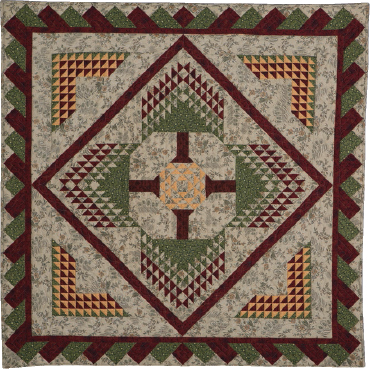 Pine Tree, by Rosie Grinstead, 2002
Pine Tree, by Rosie Grinstead, 2002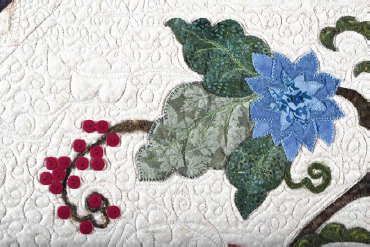 Tree of Life, detail, by Ida Houston, 2012 Ida Houstons version of a tree of life quilt, aptly named Tree of Life, was made using half-square triangles that she got through an exchange done through the The Quilt Shows on-line forum. After watching Edyta Sitar on The Quilt Show with Alex Anderson and Ricky Tims, quilters from all over the world sent in half-square triangles to exchange with each other. More than 600 people participated in the exchange. Ida wanted to make a statement with her quilt of triangles from many lands.
Tree of Life, detail, by Ida Houston, 2012 Ida Houstons version of a tree of life quilt, aptly named Tree of Life, was made using half-square triangles that she got through an exchange done through the The Quilt Shows on-line forum. After watching Edyta Sitar on The Quilt Show with Alex Anderson and Ricky Tims, quilters from all over the world sent in half-square triangles to exchange with each other. More than 600 people participated in the exchange. Ida wanted to make a statement with her quilt of triangles from many lands.
Deciding the quilt grew from a seed that had been planted with many hands of many friends, she decided it had to be a Tree of Life. The triangles that did not fit onto the front of the quilt went onto the back to cover the label. She didnt want to leave anyone out. For the tree, she took one of her old dishes and traced the design. She had it enlarged to accommodate the 36" center medallion. 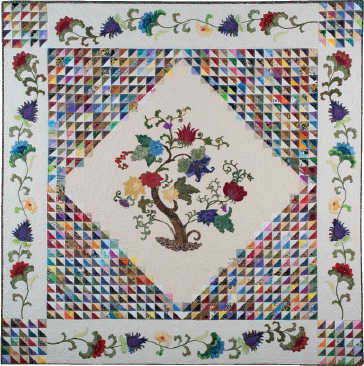 Tree of Life, by Ida Houston, 2012 The Times and Seasons quilt was designed for the 1993 Piecemakers Quilt Calendar.
Tree of Life, by Ida Houston, 2012 The Times and Seasons quilt was designed for the 1993 Piecemakers Quilt Calendar.  Tree of Life, by Ida Houston, 2012 The Times and Seasons quilt was designed for the 1993 Piecemakers Quilt Calendar.
Tree of Life, by Ida Houston, 2012 The Times and Seasons quilt was designed for the 1993 Piecemakers Quilt Calendar.
It is pieced and appliqud, and it moves away from the half-square triangle design. The blocks that make up the treetop include animals, a girl and flowers definitely representative of life. 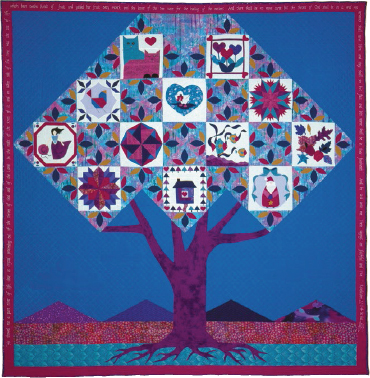 Times and Seasons, 1993, by Piecemakers, 1993 I love a quilt that draws the viewer in a quilt where you dont see everything the first time that you look at it. This is one of those quilts. His Majesty The Tree, was designed for the 2002 Piecemakers Times and Seasons Quilt Calendar. The center medallion depicts a tree through the seasons surrounded by a variety of trees going through the seasons.
Times and Seasons, 1993, by Piecemakers, 1993 I love a quilt that draws the viewer in a quilt where you dont see everything the first time that you look at it. This is one of those quilts. His Majesty The Tree, was designed for the 2002 Piecemakers Times and Seasons Quilt Calendar. The center medallion depicts a tree through the seasons surrounded by a variety of trees going through the seasons.
If you look carefully, youll see other signs of life tucked in and around the trees. I find something new in this quilt every time I look at it. 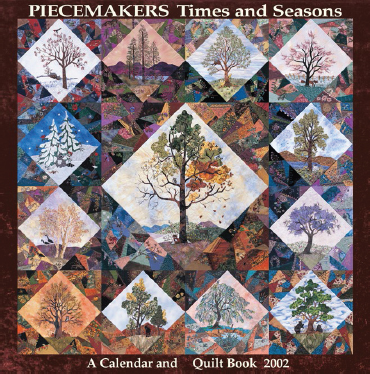 His Majesty - The Tree, by Piecemakers, 2002 Theresa DeFores Tree of Life quilt is all appliqu. She made it while undergoing cancer treatment, and each leaf is signed by friends, family and her medical staff. Some include small drawings or words of encouragement. She came up with a beautiful way to surround herself with those who loved her.
His Majesty - The Tree, by Piecemakers, 2002 Theresa DeFores Tree of Life quilt is all appliqu. She made it while undergoing cancer treatment, and each leaf is signed by friends, family and her medical staff. Some include small drawings or words of encouragement. She came up with a beautiful way to surround herself with those who loved her.
This quilt inspired the quilt Life Surrounds that you will see later in this book. 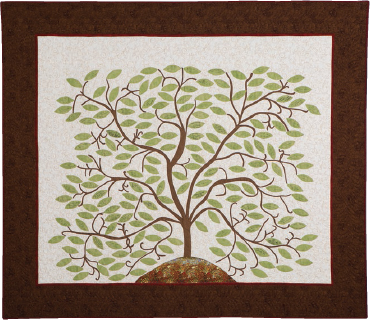 Tree of Life, by Theresa DeFore, 2011
Tree of Life, by Theresa DeFore, 2011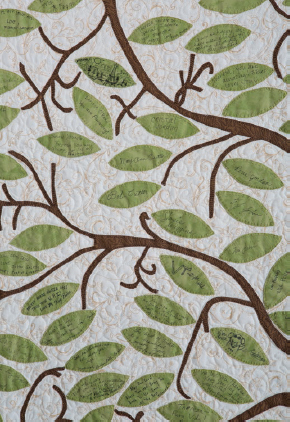 My own small art quilt, Who Am I, was inspired by the Tree of Life motif. At my core, I am defined by my family and thats what I wanted to depict in this art piece that was for the Who Am I? challenge issued by the Mo-Kan Machine Quilters Guild in 2011. The quilt was made primarily with inks and is an image of my hands supported by my husbands hands holding a seedling that represents my children. Three leaves with their names quilted in each as the veins of the leaf.
My own small art quilt, Who Am I, was inspired by the Tree of Life motif. At my core, I am defined by my family and thats what I wanted to depict in this art piece that was for the Who Am I? challenge issued by the Mo-Kan Machine Quilters Guild in 2011. The quilt was made primarily with inks and is an image of my hands supported by my husbands hands holding a seedling that represents my children. Three leaves with their names quilted in each as the veins of the leaf. 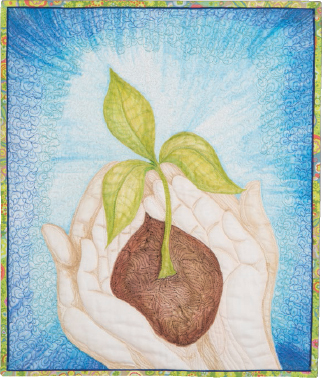 Who Am I?, by Trisch Price, 2011 Taking in all of these ideas, I began to work on my own series.
Who Am I?, by Trisch Price, 2011 Taking in all of these ideas, I began to work on my own series.
I started by asking myself questions and presenting design challenges to myself. Some if these include: How do I work with a single shape? The answer appears in Coral Reef, Circle of Life, One Tree and Web of Life. What would define a tree and life in different settings, such as a city or a suburb? This inspired City Park and Street Trees. How does the concept of a tree apply to different environments? This was the basis for Coral Reef and Web of Life
Next page

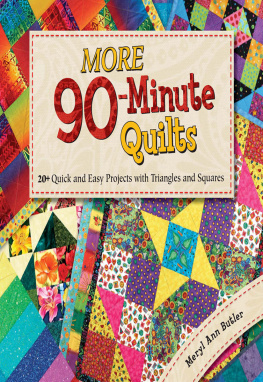

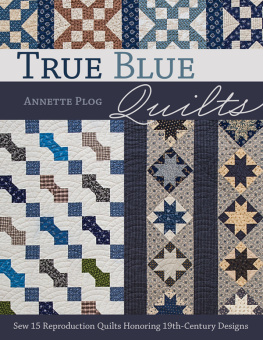
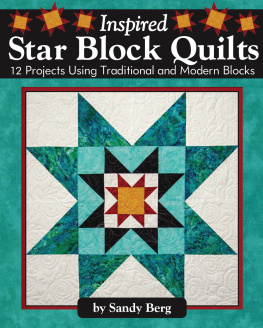
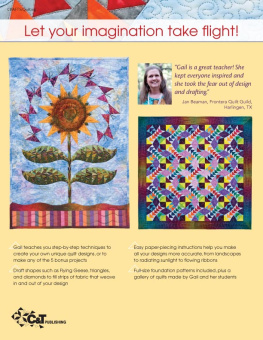
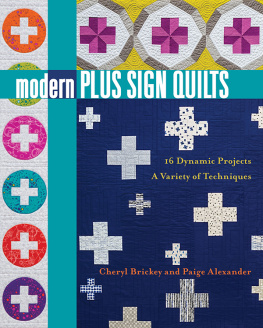



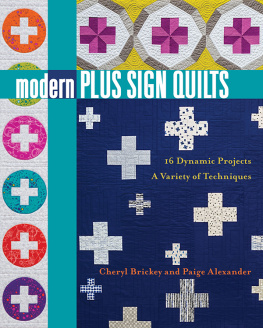

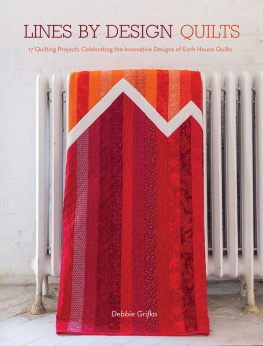
 Publisher: AMY MARSON Creative Director: GAILEN RUNGE Editor: JENIFER DICK Technical Editor: NAN POWELL Cover/Book Designer: SARAH MEIERS Illustrator: LOGAN WRIGHT All photography by AARON T. LEIMKUEHLER Published by Stash Books, an imprint of C&T Publishing, Inc., P.O. Box 1456, Lafayette, CA 94549 ACKNOWLEDGEMENTS For my husband, Ray; and three children: Nick, Tyler and Kiley; for putting up with the whole book writing and quilt making process.They are my tree of life.
Publisher: AMY MARSON Creative Director: GAILEN RUNGE Editor: JENIFER DICK Technical Editor: NAN POWELL Cover/Book Designer: SARAH MEIERS Illustrator: LOGAN WRIGHT All photography by AARON T. LEIMKUEHLER Published by Stash Books, an imprint of C&T Publishing, Inc., P.O. Box 1456, Lafayette, CA 94549 ACKNOWLEDGEMENTS For my husband, Ray; and three children: Nick, Tyler and Kiley; for putting up with the whole book writing and quilt making process.They are my tree of life. TRADITIONAL INSPIRATION I have always loved Tree of Life quilts and motifs in general. I have had a design in my head for years that I have always imagined I would make based on the more historical Tree of Life tapestries and textiles that depict an elaborate tree filled with animals hidden in every nook and cranny. I still think I might make that quilt someday probably on a smaller scale than I originally thought. I love the diversity, breadth of design and longevity of Tree of Life designs.
TRADITIONAL INSPIRATION I have always loved Tree of Life quilts and motifs in general. I have had a design in my head for years that I have always imagined I would make based on the more historical Tree of Life tapestries and textiles that depict an elaborate tree filled with animals hidden in every nook and cranny. I still think I might make that quilt someday probably on a smaller scale than I originally thought. I love the diversity, breadth of design and longevity of Tree of Life designs. Pine Tree, by Mary Johnson, 1850 This next quilt is a simpler version of a pieced Tree of Life called Pine Trees.
Pine Tree, by Mary Johnson, 1850 This next quilt is a simpler version of a pieced Tree of Life called Pine Trees.  Pine Tree, by Rosie Grinstead, 2002
Pine Tree, by Rosie Grinstead, 2002 Tree of Life, detail, by Ida Houston, 2012 Ida Houstons version of a tree of life quilt, aptly named Tree of Life, was made using half-square triangles that she got through an exchange done through the The Quilt Shows on-line forum. After watching Edyta Sitar on The Quilt Show with Alex Anderson and Ricky Tims, quilters from all over the world sent in half-square triangles to exchange with each other. More than 600 people participated in the exchange. Ida wanted to make a statement with her quilt of triangles from many lands.
Tree of Life, detail, by Ida Houston, 2012 Ida Houstons version of a tree of life quilt, aptly named Tree of Life, was made using half-square triangles that she got through an exchange done through the The Quilt Shows on-line forum. After watching Edyta Sitar on The Quilt Show with Alex Anderson and Ricky Tims, quilters from all over the world sent in half-square triangles to exchange with each other. More than 600 people participated in the exchange. Ida wanted to make a statement with her quilt of triangles from many lands. Tree of Life, by Ida Houston, 2012 The Times and Seasons quilt was designed for the 1993 Piecemakers Quilt Calendar.
Tree of Life, by Ida Houston, 2012 The Times and Seasons quilt was designed for the 1993 Piecemakers Quilt Calendar.  Times and Seasons, 1993, by Piecemakers, 1993 I love a quilt that draws the viewer in a quilt where you dont see everything the first time that you look at it. This is one of those quilts. His Majesty The Tree, was designed for the 2002 Piecemakers Times and Seasons Quilt Calendar. The center medallion depicts a tree through the seasons surrounded by a variety of trees going through the seasons.
Times and Seasons, 1993, by Piecemakers, 1993 I love a quilt that draws the viewer in a quilt where you dont see everything the first time that you look at it. This is one of those quilts. His Majesty The Tree, was designed for the 2002 Piecemakers Times and Seasons Quilt Calendar. The center medallion depicts a tree through the seasons surrounded by a variety of trees going through the seasons. His Majesty - The Tree, by Piecemakers, 2002 Theresa DeFores Tree of Life quilt is all appliqu. She made it while undergoing cancer treatment, and each leaf is signed by friends, family and her medical staff. Some include small drawings or words of encouragement. She came up with a beautiful way to surround herself with those who loved her.
His Majesty - The Tree, by Piecemakers, 2002 Theresa DeFores Tree of Life quilt is all appliqu. She made it while undergoing cancer treatment, and each leaf is signed by friends, family and her medical staff. Some include small drawings or words of encouragement. She came up with a beautiful way to surround herself with those who loved her. Tree of Life, by Theresa DeFore, 2011
Tree of Life, by Theresa DeFore, 2011 My own small art quilt, Who Am I, was inspired by the Tree of Life motif. At my core, I am defined by my family and thats what I wanted to depict in this art piece that was for the Who Am I? challenge issued by the Mo-Kan Machine Quilters Guild in 2011. The quilt was made primarily with inks and is an image of my hands supported by my husbands hands holding a seedling that represents my children. Three leaves with their names quilted in each as the veins of the leaf.
My own small art quilt, Who Am I, was inspired by the Tree of Life motif. At my core, I am defined by my family and thats what I wanted to depict in this art piece that was for the Who Am I? challenge issued by the Mo-Kan Machine Quilters Guild in 2011. The quilt was made primarily with inks and is an image of my hands supported by my husbands hands holding a seedling that represents my children. Three leaves with their names quilted in each as the veins of the leaf.  Who Am I?, by Trisch Price, 2011 Taking in all of these ideas, I began to work on my own series.
Who Am I?, by Trisch Price, 2011 Taking in all of these ideas, I began to work on my own series.